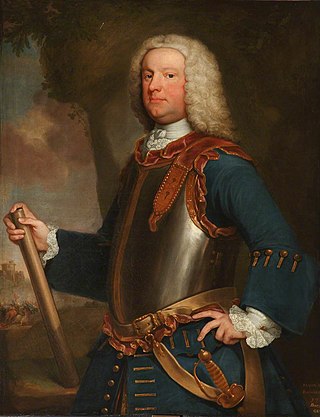Related Research Articles

Field Marshal François de La Rochefoucauld, Marquis de Montandre, also known as Francis de La Rochefoucauld, was a British soldier, who arrived in England as a Huguenot refugee. After serving as a junior officer during the Williamite War in Ireland, he was given command of Francis du Cambon's Regiment of Foot and led his regiment in the Low Countries during the Nine Years' War. He also fought at the Siege of Badajoz and at the Battle of Alcantara during the War of the Spanish Succession. He went on to be Master General of the Ordnance in Ireland.

Field Marshal Sir Robert Rich, 4th Baronet was a British cavalry officer. As a junior officer he fought at the Battle of Schellenberg and at the Battle of Blenheim during the War of the Spanish Succession. He was then asked to raise a regiment to combat the threat from the Jacobite rising of 1715. He also served with the Pragmatic Army under the Earl of Stair at the Battle of Dettingen during the War of the Austrian Succession. As a Member of Parliament he represented three different constituencies but never attained political office.
Field Marshal James O'Hara, 2nd Baron Tyrawley and 1st Baron Kilmaine, PC, was an Irish officer in the British Army. After serving as a junior officer in Spain and the Low Countries during the War of the Spanish Succession, he went on to become British ambassador to Lisbon establishing a close relationship with King John V there. He undertook a tour as British ambassador to Saint Petersburg before becoming Governor of Gibraltar where he set about improving the fortifications. He was briefly commander of British troops in Portugal during the Seven Years' War but was replaced within a few months. During his military career, he was colonel of eight different regiments.
General Sir Charles Howard KB, styled The Honourable from birth, was a British soldier and politician.
Brigadier-General John Middleton MP was a British Army officer and Scottish Whig politician who sat in the House of Commons almost continuously between 1713 and 1739.

Lieutenant-General Richard Onslow was a British Army officer and politician. After the death of their parents, his older brother Arthur bought him a captain's commission in the British Army. He first saw action in the Anglo-Spanish War in 1727, after which he was returned to Parliament for the family borough of Guildford. His political contributions were negligible in comparison to his brother, and he continued to serve as a career officer, holding commands in the War of the Austrian Succession at Dettingen and Fontenoy. In 1759, he was appointed Governor of Plymouth and commander of the Western District, and died as a lieutenant-general the following year while presiding over two prominent courts-martial.

Charles Cathcart, 8th Lord Cathcart was a British Army officer and peer.
Stephen Cornwallis was a career British Army officer and politician who sat in the House of Commons from 1727 to 1743. He reached the rank of major-general in the Army.
George Reade, of Shipton-under-Wychwood, Oxfordshire, was a British Army officer and Whig politician who sat in the House of Commons from 1722 to 1734.
General Sir Philip Honywood KB was a British Army officer.
Lieutenant-General James Tyrrell of Shotover, Oxfordshire, was a British Army officer and Whig politician who sat in the House of Commons from 1722 to 1742.
Thomas Pearce, PC was an English army officer, a privy councillor and a member of parliament. During the War of the Spanish Succession he was deputy commander-in-chief in Portugal later serving in Gibraltar. He was appointed to Ireland in 1715, spending his last five years in Dublin where he died in 1739, General of his Majesty's Forces in Ireland.

Brigadier-General Thomas Paget was a British Army officer and politician who sat in the House of Commons from 1722 to 1727. He was the ancestor of the Paget family, Marquesses of Anglesey.
Brigadier-General William Newton was an officer of the British Army.
Lieutenant-General Edward Pole was an officer of the British Army.
Major-General The Hon. William Herbert was a British Army officer and politician. He was the fifth son of Thomas Herbert, 8th Earl of Pembroke by his wife Margaret, daughter of Sir Robert Sawyer of Highclere.
Lieutenant-General Thomas Howard was an officer of the British Army and the ancestor of the family of the present Earls of Effingham.
Major-General John Moyle was an officer of the British Army.
Lieutenant-General Robert Napier was an officer of the British Army.
Lieutenant-General Edmund Fielding was a British Army officer.
References
- 1 2 A List of the Colonels, Lieutenant Colonels, Majors, Captains, Lieutenants, and Ensigns of His Majesty's Forces (1740) p. 18.
- 1 2 3 4 Richard Cannon, Historical Record of the Fourth, or King's Own Regiment of Foot (1839) p. 148.
- 1 2 3 4 Richard Cannon, Historical Record of the Twenty-Second, or the Cheshire Regiment of Foot (1849) p. 52.
- ↑ Charles Dalton, English Army Lists and Commission Registers 1661-1714, volume VI (1904) p. 194.
- ↑ "No. 6572". The London Gazette . 11–15 April 1727. p. 3.
- ↑ "No. 7464". The London Gazette. 16–20 December 1735. p. 1.
- ↑ "No. 7823". The London Gazette. 14–17 July 1739. pp. 1–2.